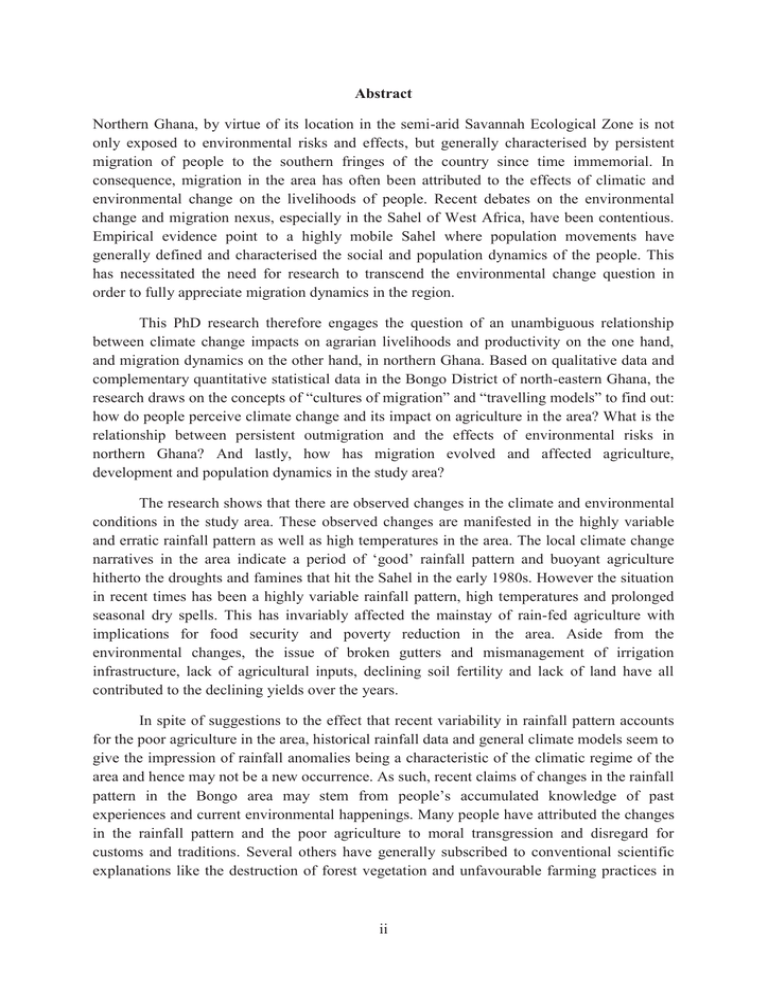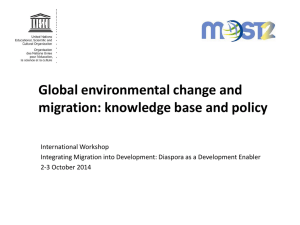Northern Ghana, by virtue of its location in the semi-arid... only exposed to environmental risks and effects, but generally characterised... Abstract
advertisement

Abstract Northern Ghana, by virtue of its location in the semi-arid Savannah Ecological Zone is not only exposed to environmental risks and effects, but generally characterised by persistent migration of people to the southern fringes of the country since time immemorial. In consequence, migration in the area has often been attributed to the effects of climatic and environmental change on the livelihoods of people. Recent debates on the environmental change and migration nexus, especially in the Sahel of West Africa, have been contentious. Empirical evidence point to a highly mobile Sahel where population movements have generally defined and characterised the social and population dynamics of the people. This has necessitated the need for research to transcend the environmental change question in order to fully appreciate migration dynamics in the region. This PhD research therefore engages the question of an unambiguous relationship between climate change impacts on agrarian livelihoods and productivity on the one hand, and migration dynamics on the other hand, in northern Ghana. Based on qualitative data and complementary quantitative statistical data in the Bongo District of north-eastern Ghana, the research draws on the concepts of “cultures of migration” and “travelling models” to find out: how do people perceive climate change and its impact on agriculture in the area? What is the relationship between persistent outmigration and the effects of environmental risks in northern Ghana? And lastly, how has migration evolved and affected agriculture, development and population dynamics in the study area? The research shows that there are observed changes in the climate and environmental conditions in the study area. These observed changes are manifested in the highly variable and erratic rainfall pattern as well as high temperatures in the area. The local climate change narratives in the area indicate a period of ‘good’ rainfall pattern and buoyant agriculture hitherto the droughts and famines that hit the Sahel in the early 1980s. However the situation in recent times has been a highly variable rainfall pattern, high temperatures and prolonged seasonal dry spells. This has invariably affected the mainstay of rain-fed agriculture with implications for food security and poverty reduction in the area. Aside from the environmental changes, the issue of broken gutters and mismanagement of irrigation infrastructure, lack of agricultural inputs, declining soil fertility and lack of land have all contributed to the declining yields over the years. In spite of suggestions to the effect that recent variability in rainfall pattern accounts for the poor agriculture in the area, historical rainfall data and general climate models seem to give the impression of rainfall anomalies being a characteristic of the climatic regime of the area and hence may not be a new occurrence. As such, recent claims of changes in the rainfall pattern in the Bongo area may stem from people’s accumulated knowledge of past experiences and current environmental happenings. Many people have attributed the changes in the rainfall pattern and the poor agriculture to moral transgression and disregard for customs and traditions. Several others have generally subscribed to conventional scientific explanations like the destruction of forest vegetation and unfavourable farming practices in ii the area. This has seen interventions aimed at tackling climate and environmental changes and the poor agricultural yields along cultural and scientific models of blame. Furthermore, the research highlights that migration in northern Ghana is a very complex phenomenon that has generally been part of the way of live of people. It is elaborated that migration is one of the responses that people make in the bid to cope with declining agricultural productivity, high levels of poverty and general food insecurity in the area. In addition to the conventional north-south migration of mostly males, the area has witnessed an imperceptible in-migration of persons into the district. A new migration trend that is gathering momentum has however been the migration of persons, mostly middle aged women, to work as farm hands or labour in the rural areas of the Northern Region of Ghana. The research notes that although the role of failing agriculture in contributing to movement cannot entirely be denied, there is not enough evidence to the suggest that environmental change directly accounts for migration of people as climate determinists may want to state as the situation in northern Ghana. The research recognises that environmental change and the associated effects may be true of the situation in the study area and as such people migrating as a coping strategy. But the same can be said of migration being an enduring theme in the area. Environmental risks and effects may thus be contextual or background factors to migration, but historical antecedents and changing socio-cultural constellations have served to sustain these movements by establishing enduring “cultures of migration” in the area. Migration in the Bongo area and for that matter northern Ghana is thus envisioned to be an integral part of the social lives of the people rather than a spontaneous or ‘knee-jerk’ response to environmental risks. The effects of migration in the district have been both positive and negative. Apart from migrant remittances contributing to improvement in household welfare, the longer duration of stay at destination areas has seen changes in household structure and the shortage of the needed household labour for the strenuous agricultural work which is typical of farming activities in northern Ghana. Also, migrants as agents of change have contributed to community development and social transformation in the Bongo area. Migrant returnees have contributed to infrastructural development, the transfer of knowledge and experience in farming practices. In-migrants, on the other hand, have contributed in imparting knowledge, employable skills and stimulating economic activities in the area. The research further highlights that in spite of the persistent exodus of people, there is a seemingly growing disinterest in migration to the south of the country. The growing disinterest stems from the unfavourable economic conditions and bad experiences of people who have returned from southern Ghana in recent times. iii From the empirical insights therefore, the research acknowledges that the effects of environmental risks on livelihoods and economic motivations cannot entirely be absolved in the explanation of migration dynamics in the study area. It is, however, stressed that the migration phenomenon is inalienably part of the socio-cultural and economic structure of rural communities in northern Ghana. The overemphasis of environmental risk factors and natural resources scarcity as the primary causes of migration in northern Ghana may therefore be insufficient and unsustainable. This is because migration is rooted in the minds of people and hence will continue to be persistent irrespective of the environmental, climatic and agricultural situation in the area. In view of this, the research therefore makes several policy recommendations at dealing with the loss of human capital, poverty reduction, bridging the north-south development gap in the country and improving agriculture as well as effective environmental management. iv






